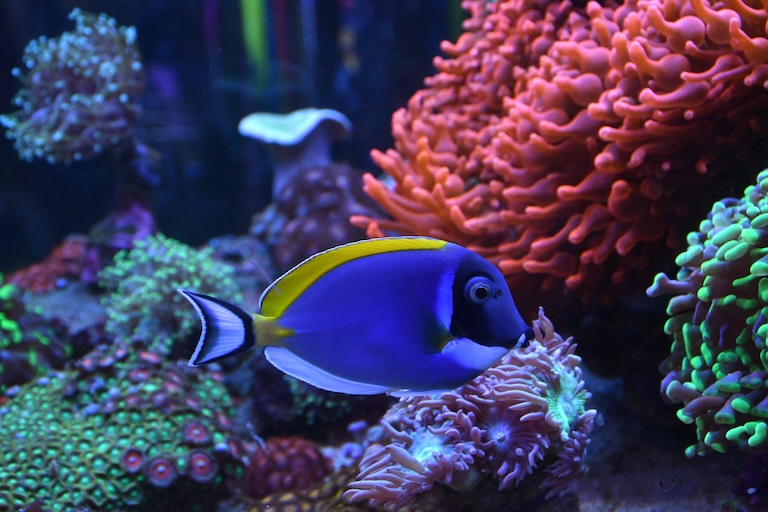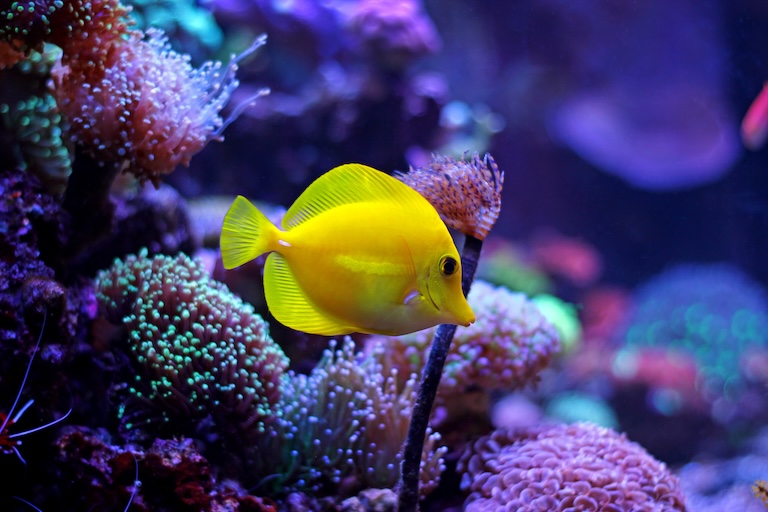Tang Profile
Among reef fishes, there are few as brightly coloured as the tangs. This family of fish, sometimes called surgeon or doctor fish, contains some of the prettiest animals in nature, and among the plethora of species, there is tremendous diversity of colours and patterns.
A healthy tang has a slippery, colourful and clean presence, and when taken care of properly, can bring great pleasure to those lucky enough to own one, but as with all things in nature, it’s best observed in its natural habitat.

Tang Facts Overview
| Habitat: | Tropical marine, shallow, reef (2 to 40 metres deep) |
| Location: | Worldwide in the tropics |
| Lifespan: | Some more than 30 years |
| Size: | From 20 cm to 2 metres (8 to 80 inches) |
| Weight: | Up to |
| Colour: | Usually brightly coloured with contrast and patterns |
| Diet: | Omnivorous |
| Predators: | Larger fish, sharks, crabs, and octopuses. |
| Top Speed: | Not recorded |
| No. of Species: | 80+ |
| Conservation Status: | Most are Least Concern, some Vulnerable |
Tang is one of those words that means several entirely unrelated things. It can be the taste of the sea air, an electric SUV, the extension of a knife blade that sits within its handle, or an early, orange pioneer of the American obesity epidemic. There’s also that confoundingly enduring song from the ‘50s about a witch doctor.
So, for the fish, it’s appropriate that tangs come in all shapes and sizes, with different attitudes and behaviours to boot. But these are more than just shiny objects; tang are critical to the health of the reefs they belong in, too.
Interesting Tang Facts
1. Tang of all colours
Most of the defining characteristics of a tang can be found close to the anus. Tangs are members of a family of fish commonly identified by the presence of a “caudal peduncle”, which is a polite way of saying butt stalk.
This stalk is what gives them their other names: Surgeon, or doctor fish, as it’s said to look a bit like a scalpel.
But other than that, these fish are similar only in rough shape and size – their colours, as vibrant as they almost always are, are dazzlingly varied, and this is one of the things that makes them so popular.

2. They’re coveted
Tang can be found in the reef habitats all over the tropics, and are responsible for adding a significant amount of the incredible colours found there. Species like the regal blue tang brighten up reefs in the Indo-Pacific, while the yellow tang can be found all the way over in the Atlantic, off the coast of Florida.
Thankfully, both of these species, as well as many others, can now be bred well in captivity, and so wild populations of these species aren’t likely to be threatened by the market for aquarium fish. But others aren’t yet out of the woods.
3. Fishing for tang
Convict Tang have the coolest name of any tangs and are so-called because of the vertical bars along their flanks. These can sell for up to $70 USD or more, and are still often collected from the wild, though they are emerging as a captive-bred species, too.
So, there’s money to be made from these fish, and the blue tang is another example of an animal that can’t be bred easily in captivity. After being made famous in Finding Dory, people were worried this species would suffer a wave of wild collections to meet a fad of demand for it in the home.
Coined the “Nemo Effect”, this phenomenon thankfully didn’t appear to have any backing when examined scientifically, and the species is still doing well, but the pet trade is always at the mercy of market fads and has a lot of potential to decimate wild populations. 1 2
4. Aggressive tang
Tangs in captivity bring up some reports of aggression, and this may or may not reflect their natural state, but as with any captive animal, certain conditions can exacerbate this condition.
Close quarters bring stress, as well as increasing the likelihood of competition for food. These are primarily algae-eaters, but will still feel the need to defend their little plot against others who might try to steal their food.
Keepers report also that some tang species can keep grudges for a long time, and once they make enemies, they may never forgive.
As usual, a lot of the issues with keeping fish in captivity can be entirely averted with the simple approach of employing the theory of mind. Fish are not mere ornaments; they have their own ideas, desires, friends and enemies. They feel things, too, and so a bit of consideration for their mental health goes a long way. 3

5. Lipstick tang
If it is a better example of a fish that looks like it was drawn by a very lonely cartoonist, we have yet to find it. The lipstick tang is one that goes for more than $100 US and sports some bright orange lips and a cute eye mask.
This fish looks a bit like it was blasted with Homer Simpson’s makeup gun, but it is a great example of the variety you can find among the tang family. This one also has tail spines and will defend itself with strikes from the back end, which is also just really cool. Many tangs have this ability, and in aquariums where they’re kept too tightly together, it can even be lethal. 4 5
6. Diseased tangs
pH is very important to the health of any tang, as is salinity, as you’d expect from a marine fish. Home aquariums are never as healthy as the open reef, but it should be possible to maintain conditions within a good range for most species.
If conditions aren’t controlled carefully, though, disease can spread, and tangs can be very sensitive to this. For this reason, quarantine is applied to any tang for a period of time before it’s introduced to an aquarium.
Wild-caught tangs for food can also bioaccumulate dangerous toxins and can, in some cases, make people very sick, too. 6
7. They’re reef guardians
As pretty and popular as they are in the home aquariums, tang belong in the wild, and they are more than ornamental there, too.
They are technically omnivores, but will mostly eat algae, which grows on the reef. Without the presence of these feeders, cleaning up the corals, the reef can suffocate or become infected, too.
And at the other end, these beautiful fish provide food for the larger animals on the reef, too, including sharks and octopuses.
So, they’re significant in their ecosystem services, and visiting them in the wild can often even contribute to their protection.

Tang Fact-File Summary
Scientific Classification
| Kingdom: | Animalia |
| Phylum: | Chordata |
| Class: | Actinopterygii |
| Order: | Perciformes |
| Family: | Acanthuridae |
| Genus: | 6-9 genera |
| Species Name: | 80+ species |
Fact Sources & References
- Militz et. al (2017), “The “Nemo Effect”: Perception and reality of Finding Nemo ‘s impact on marine aquarium fisheries”, ResearchGate.
- (2019), “’The Nemo effect’ is untrue: animal movies promote awareness, not harm”, University of Oxford.
- 4FordFamily (2015), “Tang Aggression – Understanding and Combating”, Reef2Reef.
- Naso elegans , “Lipstick Tang – West Ind Ocean”, Tropical Marine Centre.
- (2009), “killer tang????”, Saltwater Fish.
- , “Blue tang”, National Geographic.
